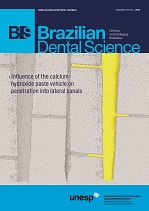Influence of the calcium hydroxide paste vehicle on penetration into lateral canals
DOI:
https://doi.org/10.14295/bds.2018.v21i3.1574Resumo
Objective: The aim of this study was to use Micro computed tomography (micro-CT) to evaluate the influence of the type of vehicle associated with calcium hydroxide on its ability to penetrate simulated lateral canals. Material and methods: 30 acrylic blocks with simulated lateral canals comprising apical, middle and cervical thirds were used in the in vitro study. The blocks were divided into 3 groups (n = 10) according to the type of vehicle used (chlorhexidine, distilled water and propylene glycol) in the calcium hydroxide slurry, which was inserted in the respective group of simulated canals with a K# 30 file and then agitated with an ultrasonic tip. The blocks were scanned by micro-computed tomography (micro-CT) before and after insertion of the medication. The images obtained were reconstructed and analyzed to obtain the initial volume of lateral canals and the volume of medication that penetrated into them. Results: In the intragroup analysis, both distilled water and chlorhexidine 2% were observed to present statistical difference in all thirds of the canal. Propylene glycol showed no intragroup difference. In the inter-group analysis, the propylene glycol paste presented higher values of penetration into the simulated lateral canals than the other groups (p <0.05). Conclusion: Propylene glycol used as vehicle of the calcium hydroxide paste provided better penetration results in simulated lateral canals.
Keywords
Endodontics; Calcium hydroxide; Propylene glycol.
Downloads
Downloads
Publicado
Como Citar
Edição
Seção
Licença
TRANSFERÊNCIA DE DIREITOS AUTORAIS E DECLARAÇÃO DE RESPONSABILIDADE
Toda a propriedade de direitos autorais do artigo "____________________________________________________________________" é transferido do autor(es) para a CIÊNCIA ODONTOLÓGICA BRASILEIRA, no caso do trabalho ser publicado. O artigo não foi publicado em outro lugar e não foi submetido simultaneamente para publicação em outra revista.
Vimos por meio deste, atestar que trabalho é original e não apresenta dados manipulados, fraude ou plágio. Fizemos contribuição científica significativa para o estudo e estamos cientes dos dados apresentados e de acordo com a versão final do artigo. Assumimos total responsabilidade pelos aspectos éticos do estudo.
Este texto deve ser impresso e assinado por todos os autores. A versão digitalizada deverá ser apresentada como arquivo suplementar durante o processo de submissão.




























